
Revup provides command-line tools that allow developers to iterate faster on parallel changes and reduce the overhead of creating and maintaining code reviews.
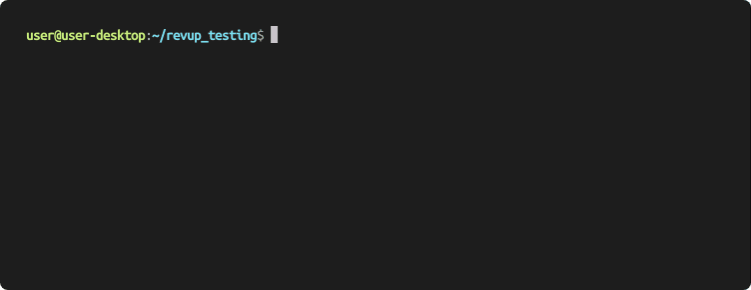
revup amend and revup restack save time by replacing slow rebasesRevup requires python 3.8 or higher and git 2.43 or higher. Revup works with Linux, OSX, and Windows (limited testing).
Follow instructions here to get the latest git version for your OS. Revup uses flags only present in newer git versions.
Install with pip or your favorite package manager.
python3.8 -m pip install revupVerify that installation was successful by showing the help page.
revup -hYou can also build from source to get the latest updates.
git clone https://github.com/Skydio/revup.git && cd revup
make deps && make package && make install
This tutorial will guide you through using basic revup features.
Clone a sandbox repo by forking revup, creating a new repo, or using some other repo you own. Creating test PRs can be spammy so don't do the tutorial on other people's repos.
git clone https://github.com/<your-name>/revup.git && cd revupOn first run, you will need to configure github credentials. Create a personal access token here and check the box for "full repo permissions". Revup needs this in order to create and modify pull requests. Then run
revup config github_oauthand copy and paste the oauth into the prompt.
Make your first two commits that will become two separate pull requests. Note the "Topic:" tag in the commit message - this is what causes revup to recognize and act on a commit. Each separately named topic will become a new pull request.
echo meh > foo; git add foo
git commit -m "My first revup foo" -m "Topic: foo"
echo peh > bar; git add bar
git commit -m "My first revup bar" -m "Topic: bar"
revup upload
You've uploaded your first revup changes! Notice how in github, both branches target 'main'. This allows them to be merged independently.
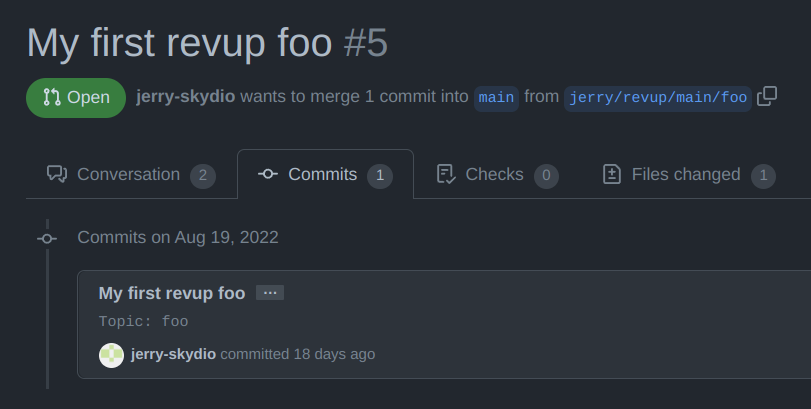
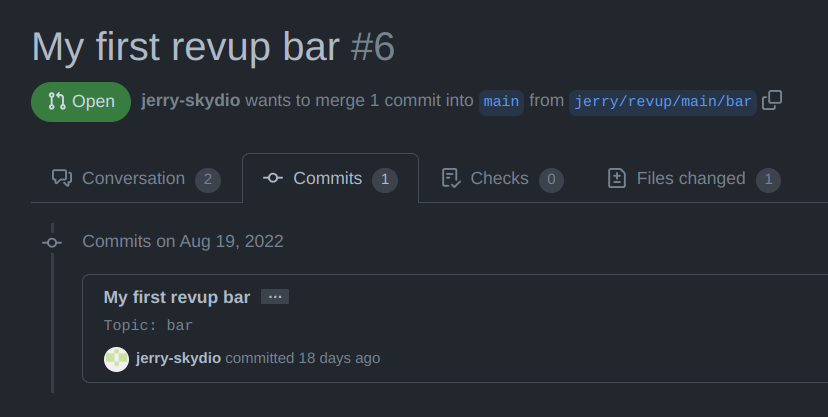
Under the hood, revup creates and pushes these branches for you, tracking and managing the dependencies as needed.
Now we'll make a new review that's relative to "foo". The "Relative" tag will ensure the new review targets the correct branch.
echo deh >> foo; git add foo
git commit -m "My second revup foo" -m "Topic: foo2" -m "Relative: foo"
revup upload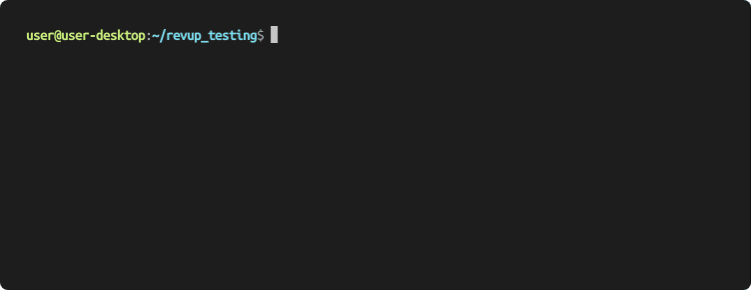
With this simple but powerful model, you can upload independent and dependent changes all at once.
Now let's update a pull request.
echo heh >> bar; git add bar
# Either
revup amend HEAD~ --no-edit # Specify a commit to amend
# or
revup amend bar --no-edit # Specify a topic name to amend
revup upload
revup amend makes it easy to modify commits in your history. You also have other options for modifying reviews:
git rebase --interactive along with git commit --amend
Use git pull --rebase to pull in changes. Don't use git merge or git pull without rebase as this creates a merge commit.
By default revup will not upload if you pull but haven't made changes to a commit. To override this and upload always, run revup upload --rebase.
[pull]
rebase = true
[rebase]
autoStash = true
We recommend adding the above to .gitconfig to make pulling and rebasing easier.
This is a non-exhaustive intro to some more handy revup features.
For a full description of features, see the docs or run revup -h or revup upload -h to view docs in man format.
For contributing to projects that you may not have push access to, revup can be configured to push to a fork while creating a pull request in the main project.
Add git remotes for both the original and fork.
$ git remote -v
origin https://github.com/ORIGINAL_OWNER/REPO_NAME.git (fetch)
origin https://github.com/ORIGINAL_OWNER/REPO_NAME.git (push)
myfork https://github.com/YOUR_USERNAME/REPO_NAME.git (fetch)
myfork https://github.com/YOUR_USERNAME/REPO_NAME.git (push)
When uploading, pass the remote to create the pull request in as --remote-name and the forked remote as --fork-name.
revup --remote-name origin --fork-name myfork upload
Revup can also add reviewers, assignees, and labels to pull requests. Add the appropriate tags to any commit in a topic.
Reviewers: alice, bob
Assignees: eve
Labels: bug, feature, draft
Github usernames can be abbreviated and will match the shortest name with the given prefix.
Labels must match exactly. The draft label is special and will make a pull request a draft if present and unmake draft if removed.
Revup normally auto-detects your local base branch and uses that to list commits and target reviews. You can choose to target any particular topic to another branch or even multiple branches, in which case revup will use those as the base branch instead (and create multiple pull requests in the latter case).
A fix for multiple branches
Topic: fix
Branches: main, rel1.1
You can specify base branch on the command line as well, although this is usually not necessary unless you're working on a branch that the autodetector doesn't know about (see Repo config below).
revup upload --base-branch custom-branch-name
Revup will add 2 comments in every pull request to provide helpful features for users and reviewers. These are enabled by default and automatically updated as the pull request changes.
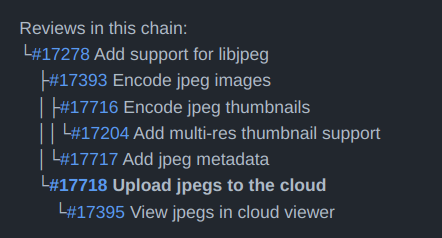
The review graph provides links and titles to all local pull requests that have a relative relationship with the current pull request, including any that it depends on, or that depend on it. This allows you to quickly browse between pull requests in a chain.
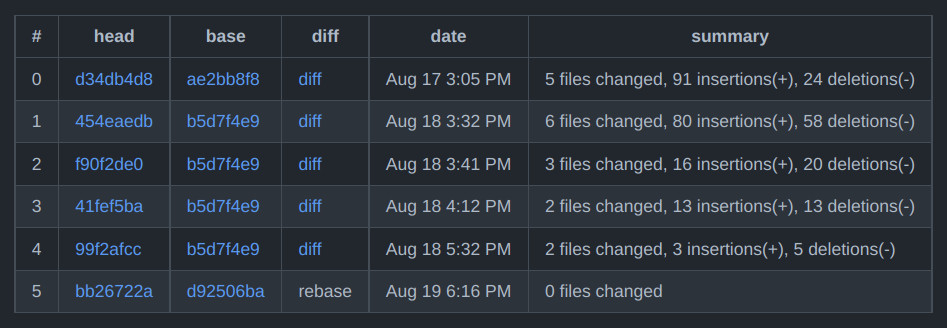
The patchsets table provides a history of uploads for a given pull request as well as links and summaries of the diff between each upload. Notably, revup specially handles the case where you rebase then upload and will show you a diff with upstream files excluded.
Revup is highly configurable using a standard config file format. Every flag is also a config option, so users can get the exact behavior they need.
Flags specified on the command line take precedence, followed by config in ~/.revupconfig, followed by .revupconfig in the current repo.
The primary usecase for the in-repo config file is setting up the naming of the main branch and release branches.
For example if your main branch is master and release branches are named like rel1.1, commit the following to .revupconfig in the repo root.
[revup]
main_branch = master
base_branch_globs =
rel[1-9].[0-9]
rel[1-9].[0-9][0-9]
The user config at ~/.revupconfig saves time by defaulting the most commonly used flags.
For example, after getting used to the workflow, a user might not need the confirmation check. Adding the following lines will be the same as running with --skip-confirm.
[upload]
skip_confirm = True
(aka "stacked diffs", "patch based", etc)
If you've used tools such as Gerrit, Phabricator, or git mailing lists, you may already be familiar with this style of development. If you'd like to read more, here are some well written discussions on the subject.
Revup is inspired in part by this non-exhaustive list of open source projects that also support a patch based workflow:
revup upload but doesn't push or create reviews.revup amend and the backend for the above with a merge system that handles conflictsThanks for contributing to revup! You can get started with your own idea, or see the issues page for ideas that other people are excited about.
When reporting issues:
revup -v to provide verbose logs.Revup is published by Skydio but is not an officially supported Skydio product.